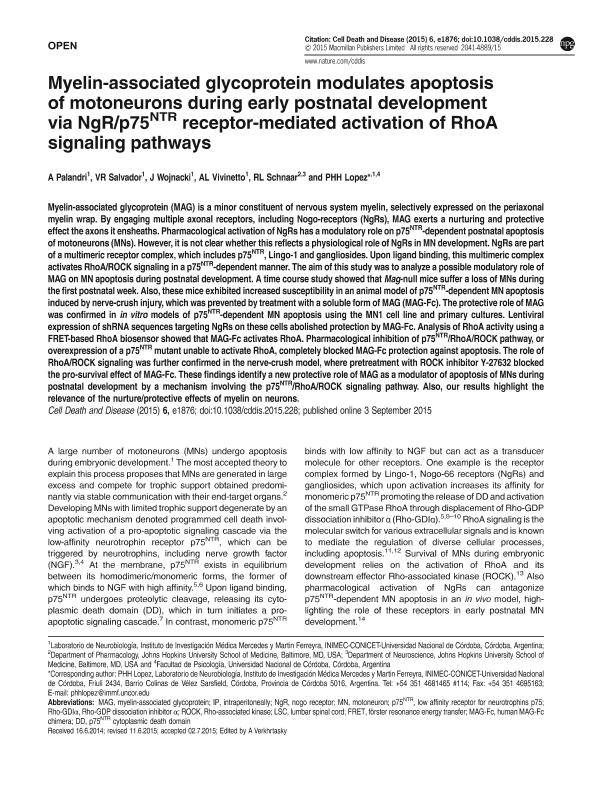Mostrar el registro sencillo del ítem
dc.contributor.author
Palandri, Anabela

dc.contributor.author
Rozés Salvador, María Victoria

dc.contributor.author
Wojnacki Fonseca, José Ignacio

dc.contributor.author
Vivinetto, Ana Laura

dc.contributor.author
Schnaar, R. L.
dc.contributor.author
Lopez Piñeyro, Hernán Ignacio

dc.date.available
2019-02-05T15:34:57Z
dc.date.issued
2015-09
dc.identifier.citation
Palandri, Anabela; Rozés Salvador, María Victoria; Wojnacki Fonseca, José Ignacio; Vivinetto, Ana Laura; Schnaar, R. L.; et al.; Myelin-associated glycoprotein modulates apoptosis of motoneurons during early postnatal development via NgR/p75 NTR receptor-mediated activation of RhoA signaling pathways; Nature Publishing Group; Cell Death and Disease; 6; 9-2015; 1-12
dc.identifier.issn
2041-4889
dc.identifier.uri
http://hdl.handle.net/11336/69413
dc.description.abstract
Myelin-associated glycoprotein (MAG) is a minor constituent of nervous system myelin, selectively expressed on the periaxonal myelin wrap. By engaging multiple axonal receptors, including Nogo-receptors (NgRs), MAG exerts a nurturing and protective effect the axons it ensheaths. Pharmacological activation of NgRs has a modulatory role on p75 NTR -dependent postnatal apoptosis of motoneurons (MNs). However, it is not clear whether this reflects a physiological role of NgRs in MN development. NgRs are part of a multimeric receptor complex, which includes p75 NTR, Lingo-1 and gangliosides. Upon ligand binding, this multimeric complex activates RhoA/ROCK signaling in a p75 NTR -dependent manner. The aim of this study was to analyze a possible modulatory role of MAG on MN apoptosis during postnatal development. A time course study showed that Mag-null mice suffer a loss of MNs during the first postnatal week. Also, these mice exhibited increased susceptibility in an animal model of p75 NTR -dependent MN apoptosis induced by nerve-crush injury, which was prevented by treatment with a soluble form of MAG (MAG-Fc). The protective role of MAG was confirmed in in vitro models of p75 NTR -dependent MN apoptosis using the MN1 cell line and primary cultures. Lentiviral expression of shRNA sequences targeting NgRs on these cells abolished protection by MAG-Fc. Analysis of RhoA activity using a FRET-based RhoA biosensor showed that MAG-Fc activates RhoA. Pharmacological inhibition of p75 NTR /RhoA/ROCK pathway, or overexpression of a p75 NTR mutant unable to activate RhoA, completely blocked MAG-Fc protection against apoptosis. The role of RhoA/ROCK signaling was further confirmed in the nerve-crush model, where pretreatment with ROCK inhibitor Y-27632 blocked the pro-survival effect of MAG-Fc. These findings identify a new protective role of MAG as a modulator of apoptosis of MNs during postnatal development by a mechanism involving the p75 NTR /RhoA/ROCK signaling pathway. Also, our results highlight the relevance of the nurture/protective effects of myelin on neurons.
dc.format
application/pdf
dc.language.iso
eng
dc.publisher
Nature Publishing Group
dc.rights
info:eu-repo/semantics/openAccess
dc.rights.uri
https://creativecommons.org/licenses/by-nc-sa/2.5/ar/
dc.subject
Myelin-Associated Glycoprotein
dc.subject
Apoptosis
dc.subject
Motoneurons
dc.subject
P75(Ntr)
dc.subject.classification
Otras Ciencias Biológicas

dc.subject.classification
Ciencias Biológicas

dc.subject.classification
CIENCIAS NATURALES Y EXACTAS

dc.title
Myelin-associated glycoprotein modulates apoptosis of motoneurons during early postnatal development via NgR/p75 NTR receptor-mediated activation of RhoA signaling pathways
dc.type
info:eu-repo/semantics/article
dc.type
info:ar-repo/semantics/artículo
dc.type
info:eu-repo/semantics/publishedVersion
dc.date.updated
2019-02-04T13:16:57Z
dc.journal.volume
6
dc.journal.pagination
1-12
dc.journal.pais
Reino Unido

dc.journal.ciudad
Londres
dc.description.fil
Fil: Palandri, Anabela. Consejo Nacional de Investigaciones Científicas y Técnicas. Centro Científico Tecnológico Conicet - Córdoba. Instituto de Investigación Médica Mercedes y Martín Ferreyra. Universidad Nacional de Córdoba. Instituto de Investigación Médica Mercedes y Martín Ferreyra; Argentina
dc.description.fil
Fil: Rozés Salvador, María Victoria. Consejo Nacional de Investigaciones Científicas y Técnicas. Centro Científico Tecnológico Conicet - Córdoba. Instituto de Investigación Médica Mercedes y Martín Ferreyra. Universidad Nacional de Córdoba. Instituto de Investigación Médica Mercedes y Martín Ferreyra; Argentina
dc.description.fil
Fil: Wojnacki Fonseca, José Ignacio. Consejo Nacional de Investigaciones Científicas y Técnicas. Centro Científico Tecnológico Conicet - Córdoba. Instituto de Investigación Médica Mercedes y Martín Ferreyra. Universidad Nacional de Córdoba. Instituto de Investigación Médica Mercedes y Martín Ferreyra; Argentina
dc.description.fil
Fil: Vivinetto, Ana Laura. Consejo Nacional de Investigaciones Científicas y Técnicas. Centro Científico Tecnológico Conicet - Córdoba. Instituto de Investigación Médica Mercedes y Martín Ferreyra. Universidad Nacional de Córdoba. Instituto de Investigación Médica Mercedes y Martín Ferreyra; Argentina
dc.description.fil
Fil: Schnaar, R. L.. Johns Hopkins University School of Medicine; Estados Unidos
dc.description.fil
Fil: Lopez Piñeyro, Hernán Ignacio. Consejo Nacional de Investigaciones Científicas y Técnicas. Centro Científico Tecnológico Conicet - Córdoba. Instituto de Investigación Médica Mercedes y Martín Ferreyra. Universidad Nacional de Córdoba. Instituto de Investigación Médica Mercedes y Martín Ferreyra; Argentina. Universidad Nacional de Córdoba. Facultad de Psicología; Argentina
dc.journal.title
Cell Death and Disease
dc.relation.alternativeid
info:eu-repo/semantics/altIdentifier/doi/https://dx.doi.org/10.1038/cddis.2015.228
dc.relation.alternativeid
info:eu-repo/semantics/altIdentifier/url/https://www.nature.com/articles/cddis2015228
Archivos asociados
